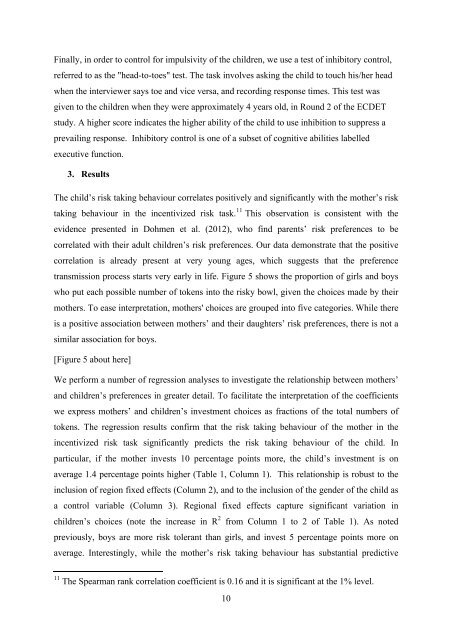Parental socialisation effort and the intergenerational transmission ...
Parental socialisation effort and the intergenerational transmission ...
Parental socialisation effort and the intergenerational transmission ...
- No tags were found...
Create successful ePaper yourself
Turn your PDF publications into a flip-book with our unique Google optimized e-Paper software.
Finally, in order to control for impulsivity of <strong>the</strong> children, we use a test of inhibitory control,referred to as <strong>the</strong> "head-to-toes" test. The task involves asking <strong>the</strong> child to touch his/her headwhen <strong>the</strong> interviewer says toe <strong>and</strong> vice versa, <strong>and</strong> recording response times. This test wasgiven to <strong>the</strong> children when <strong>the</strong>y were approximately 4 years old, in Round 2 of <strong>the</strong> ECDETstudy. A higher score indicates <strong>the</strong> higher ability of <strong>the</strong> child to use inhibition to suppress aprevailing response. Inhibitory control is one of a subset of cognitive abilities labelledexecutive function.3. ResultsThe child’s risk taking behaviour correlates positively <strong>and</strong> significantly with <strong>the</strong> mo<strong>the</strong>r’s risktaking behaviour in <strong>the</strong> incentivized risk task. 11 This observation is consistent with <strong>the</strong>evidence presented in Dohmen et al. (2012), who find parents’ risk preferences to becorrelated with <strong>the</strong>ir adult children’s risk preferences. Our data demonstrate that <strong>the</strong> positivecorrelation is already present at very young ages, which suggests that <strong>the</strong> preference<strong>transmission</strong> process starts very early in life. Figure 5 shows <strong>the</strong> proportion of girls <strong>and</strong> boyswho put each possible number of tokens into <strong>the</strong> risky bowl, given <strong>the</strong> choices made by <strong>the</strong>irmo<strong>the</strong>rs. To ease interpretation, mo<strong>the</strong>rs' choices are grouped into five categories. While <strong>the</strong>reis a positive association between mo<strong>the</strong>rs’ <strong>and</strong> <strong>the</strong>ir daughters’ risk preferences, <strong>the</strong>re is not asimilar association for boys.[Figure 5 about here]We perform a number of regression analyses to investigate <strong>the</strong> relationship between mo<strong>the</strong>rs’<strong>and</strong> children’s preferences in greater detail. To facilitate <strong>the</strong> interpretation of <strong>the</strong> coefficientswe express mo<strong>the</strong>rs’ <strong>and</strong> children’s investment choices as fractions of <strong>the</strong> total numbers oftokens. The regression results confirm that <strong>the</strong> risk taking behaviour of <strong>the</strong> mo<strong>the</strong>r in <strong>the</strong>incentivized risk task significantly predicts <strong>the</strong> risk taking behaviour of <strong>the</strong> child. Inparticular, if <strong>the</strong> mo<strong>the</strong>r invests 10 percentage points more, <strong>the</strong> child’s investment is onaverage 1.4 percentage points higher (Table 1, Column 1). This relationship is robust to <strong>the</strong>inclusion of region fixed effects (Column 2), <strong>and</strong> to <strong>the</strong> inclusion of <strong>the</strong> gender of <strong>the</strong> child asa control variable (Column 3). Regional fixed effects capture significant variation inchildren’s choices (note <strong>the</strong> increase in R 2 from Column 1 to 2 of Table 1). As notedpreviously, boys are more risk tolerant than girls, <strong>and</strong> invest 5 percentage points more onaverage. Interestingly, while <strong>the</strong> mo<strong>the</strong>r’s risk taking behaviour has substantial predictive11 The Spearman rank correlation coefficient is 0.16 <strong>and</strong> it is significant at <strong>the</strong> 1% level.10
















